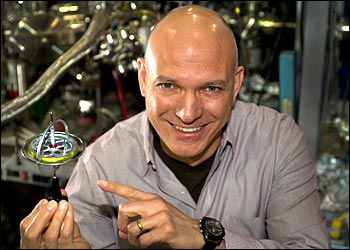Magnetic Materials, Bleeding-Edge Technology and NSLS: Questions and Answers With Brookhaven Lab’s Darío Arena
May 24, 2012

A balancing gyroscope illustrates a concept called angular momentum, which affects a magnet’s strength. At BNL’s National Synchrotron Light Source, Darío Arena studies complicated magnetic alloys containing lots of tiny “gyroscopes” for layered structures with enhanced properties in advanced applications, from cloud computing to medical imaging.
Darío Arena is a scientist at Brookhaven Lab who studies magnetic materials — not the magnets you find on a refrigerator door, but much more complex magnetic materials that are used in everything from electricity generators to computer hard drives and magnetic resonance imaging (MRI) machines that doctors use to look below our skin to diagnose health conditions.
Arena, who lives in Huntington, NY, works in BNL’s Photon Sciences Directorate at the National Synchrotron Light Source (NSLS). The NSLS is a huge machine that produces very bright light of many different wavelengths, including the x-rays that Arena needs to probe the magnetic characteristics of compounds and alloys that advance industry and technological applications.
Arena will give the 478th Brookhaven Lecture on May 24, but before that, Arena discusses his work here:
How long have you worked at BNL?
That depends on when you start counting. I came to BNL in 2001, but was employed by the Naval Research Laboratory on a National Research Council Research Fellowship. I was hired by NSLS as a postdoc in 2003 and became a member of scientific staff in 2006.
What’s cool about your work?
Without advanced magnetic materials, we could not support our technological civilization. Cloud computing, wireless communication, the Internet, advanced medical imaging and many other technologies could not exist without magnetic materials. We try to develop better materials to provide more efficient performance and even entirely new applications.
What do people need to know about magnetic materials to understand what you do?
Think how a gyroscope works. When its rotor spins fast enough, the gyroscope has two poles, a “top” and a “bottom,” and it can balance upright. This illustrates a concept we call angular momentum. The strength of a magnet relies on angular momentum of its atomic constituents. In complicated magnetic alloys, there are lots of tiny “gyroscopes” ordered in different directions and we want to assemble these magnetic materials into layered structures to enhance certain properties.
What are you working on now?
I use the special tools at NSLS to understand the origins of magnetic ordering in a variety of materials. Recently, a focus of my research has been to use the x-rays from the NSLS as a “strobe light” to examine the dynamics, or motion, of magnetism for different elements in a complicated alloy or a structure containing multiple layers. With this approach, we can resolve dynamics on a picosecond timescale, which is measured in trillionths of a second.
Why do this at BNL?
The NSLS has a long and distinguished tradition with advanced x-ray techniques to examine materials at the “bleeding edge” of technological applications, and magnetic materials have always been part of that history. The capabilities and experience found here are unique.
Have your efforts contributed to any discoveries?
Yes. For example, we have found a number of previously unreported effects such as a weak but important interaction in magnetic multilayers similar to read heads in magnetic disk drives, and an unusual “hidden” magnetic configuration in thin films of ferromagnetic oxides. This last project was identified as a Science and Technology Highlight in the Department of Energy PULSE newsletter.
Who does your work benefit?
Our research benefits U.S. industry (magnetic data storage, microwave communications and radar, and permanent magnet manufacturers). Mainly, however, it is for fundamental knowledge.
Who do you work with?
I mainly work with outside collaborators, who represent both local academic institutions such as Columbia, New York University, Yale, and Northeastern, as well as international collaborators in Sweden and the United Kingdom. Closer to home, I’ve recently started to collaborate with Dr. Yimei Zhu of Brookhaven Lab’s Condensed Matter Physics and Materials Science Department.
Who funds your work? And why are they interested in what you’re doing?
My work is funded through the NSLS and hence through the U.S. Department of Energy [DOE] Office of Science. I am also a co-recipient of an Advanced Research Projects Agency—Energy [ARPA-E] grant from the DOE. The ARPA-E program is designed to support creative unique transformational energy research that industry alone can’t or won’t support because of higher risk for failure, while success would create serious benefits for the nation.
Which award are you most proud of?
The National Research Council fellowship I received was awarded for original research and the program is quite competitive.
Do you have any special talents?
Nothing unusual, I’m afraid. For relaxation, I play volleyball and Ultimate Frisbee, and I read a lot.
What are you looking forward to for your research in the future?
I’d love to be able to continue this kind of research at NSLS-II, which will play a transformational role in my research. NSLS-II’s bright beams will allow us to focus on very small dimensions with very high beam intensity. The building will also be extremely stable to insulate experiments from vibrations that happen all around us throughout the day. That will allow us to look at magnetic materials for more subtle, smaller effects that we couldn’t see before.
2012-3093 | INT/EXT | Newsroom









